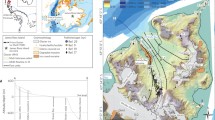Summary
Nigardsbreen (Norway) is one of the very few high-latitude glaciers from which a long record of front positions is known (starting in the beginning of the 18th century). In this paper a dynamic glacier model is used to investigate the possible causes of the observed front variations. These variations are characterized by a rapid advance until 1748, and steady retreat, with some minor interruptions, after that time.
Two time series are used as forcing functions that drive the dynamic model: (i) central England summer temperature, and (ii) a tree ring record from northern Sweden. It appears that forcing (i) does not work at all: an almost continuously growing glacier is predicted by the model. Forcing (ii) performs much better, although the maximum glacier extent comes too early.
Interpretation of these results and some additional experiments suggest that the climatic warming after the little ice age has been much more pronounced in western Norway than in England, at least in summer. Winter precipitation in Norway probably decreased gradually during the last centuries.
Zusammenfassung
Nigardsbreen (Norwegen) ist einer der wenigen Gletscher in hohen Breiten, von dem langjährige Aufzeichnungen über die Frontpositionen bekannt sind (seit Anfang des 18. Jahrhunderts). In der vorliegenden Arbeit wird zur Untersuchung der möglichen Ursachen der beobachteten Gletscherfrontveränderungen ein dynamisches Gletschermodell verwendet. Diese Veränderungen sind bis 1748 durch ein rapides Vorrücken und nach dieser Zeit durch einen, mit einigen kleinen Unterbrechungen, stetigen Rückgang gekennzeichnet.
Als Antriebsfunktionen, die das dynamische Modell treiben, werden zwei Zeitreihen verwendet: 1. Die Sommertemperaturen von Mittelengland, und 2. Jahresringaufzeichnungen aus Nordschweden. Es zeigt sich, daß der erste Antrieb überhaupt nicht funktioniert, denn dieses Modell sagt einen fast kontinuierlich wachsenden Gletscher voraus. Der zweite Antrieb funktioniert viel besser, obwohl die maximale Gletscherausdehnung zu früh auftritt.
Die Interpretation dieser Resultate und einige zusätzliche Experimente weisen darauf hin, daß die Erwärmung nach der kleinen Eiszeit im westlichen Norwegen viel ausgeprägter war als in England, wenigstens im Sommer. Der Winterniederschlag hat sich vermutlich in Norwegen während der letzten Jahrhunderte allmählich verringert.
Similar content being viewed by others
References
Budd WF, Jenssen D (1975) Numerical modelling of glacier systems. IAHS Publ 104: 257–291
Furbish DJ, Andrews JT (1984) The use of hypsometry to indicate long-term stability and response of valley glaciers to changes in mass transfer. J Glaciol 30: 199–211
Hoinkes H (1970) Methoden und Möglichkeiten von Massenhaushaltsstudien auf Gletschern. Z Gletscherk Glazialgeol 6: 38–55
Karlén W (1984) Dendrochronology, mass balance and glacier front fluctuations in northern Sweden: In: Mörner NA, Karlén W (eds) Climatic changes on a yearly to milennial basis. Reidel, Dordrecht
Kruss PD (1984) Terminus response of Lewis glacier, Mount Kenya, Kenya, to sinusoidal net-balance forcing. J Glaciol 30: 212–217
Kuhn M (1978) On the non-linearity of glacier length response to climatic changes: comments on a paper by Posamentier HW. J Glaciol 20: 443–445
Kuhn M (1984) Mass budget imbalance as criterion for a climatic classification of glaciers. Geografiska Ann 66A: 229–238
Lamb HH (1977) Climate: present, past and future, Vol 2: Climatic history and the future. Methuen, London
Letreguilly A (1984) Bilans de masse des glaciers alpins: methode de mesure et repartition spatio-temporelle. Thesis, Laboratoire de Glaciologie et de Géophysique de l'Environment (CNRS), Grenoble
Mesinger F, Arakawa A (1976) Numerical methods used in atmospheric models, vol 1. WMO, GARP Publ 17, Geneva
Nye JF (1965) The frequency response of glaciers. J Glaciol 5: 567–587
Oerlemans J, van der Veen CJ (1984) Ice sheets and climate. Reidel, Dordrecht
Østrem G, Liestøl O, Wold B (1977) Glaciological investigations at Nigardsbreen, Norway. Norsk Geogr Tidsskr 30: 187–209
Paterson WSB (1981) The physics of glaciers. Pergamon Press, Oxford
Reynaud L (1983) Recent fluctuations of alpine glaciers and their meteorological causes: 1880–1980. In: A Street Perrot et al. (eds) Variations in the global water budget. Reidel, Dordrecht, pp 197–205
Young GJ (1977) Relation between mass balance and meteorological variables on Peyto glacier, Alberta, Canada, 1967/74. Z Gletscherk Glazialgeol 13: 111–125
Author information
Authors and Affiliations
Additional information
With 8 Figures
Rights and permissions
About this article
Cite this article
Oerlemans, J. An attempt to simulate historic front variations of Nigardsbreen, Norway. Theor Appl Climatol 37, 126–135 (1986). https://doi.org/10.1007/BF00867846
Received:
Issue Date:
DOI: https://doi.org/10.1007/BF00867846




